|
|
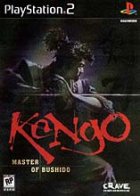
    
by Crave
|
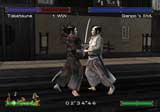 When I first tossed Kengo into my PS2, I naturally went to check out the game
options. I found the setting for "gore", and of course turned it on, and
didn’t think anymore about it. I moved on through the beginning of the game, which
consists mainly of sparring battles using wooden swords to train with members of your
dojo, and to challenge members of other dojos. The combat was pretty deep, though I
wasn’t very good yet, and sparring with wooden swords was pretty cool because the
sound is great whether it’s the wood on wood crash of a parried blow or the
satisfying thunk of wood stick meets rib cage. During one of training battles with another
dojo, I accidentally killed the head master. This didn’t sit too well with all his
students, so as I strolled back to my dojo to put up my wooden stick and grab a cup of
tea, five pissed off Samurai jumped out of the bushes. They were holding real steel
katanas instead of wooden ones, and I watched my character slowly draw the shiny steel
katana I had forgotten he was carrying. Fortunately for me, the five samurai decided to
take turns. Gone was the dull thud of wooden sticks, my living room was filled with the
sound of ringing steel, tearing flesh, and the occasional scream of pain. Blood was flying
everywhere, squirting out of slashed necks, backs, stomachs, arms, and pretty much every
other body part that can be damaged by three feet of razor sharp steel. In a few seconds
my opponent’s clothes were saturated with the same blood that was squirting out of
his neck like a geyser. In a few more seconds I was on my way back to hang in my dojo, the
badass samurai that I am, leaving five mangled corpse lying in the street. When I first tossed Kengo into my PS2, I naturally went to check out the game
options. I found the setting for "gore", and of course turned it on, and
didn’t think anymore about it. I moved on through the beginning of the game, which
consists mainly of sparring battles using wooden swords to train with members of your
dojo, and to challenge members of other dojos. The combat was pretty deep, though I
wasn’t very good yet, and sparring with wooden swords was pretty cool because the
sound is great whether it’s the wood on wood crash of a parried blow or the
satisfying thunk of wood stick meets rib cage. During one of training battles with another
dojo, I accidentally killed the head master. This didn’t sit too well with all his
students, so as I strolled back to my dojo to put up my wooden stick and grab a cup of
tea, five pissed off Samurai jumped out of the bushes. They were holding real steel
katanas instead of wooden ones, and I watched my character slowly draw the shiny steel
katana I had forgotten he was carrying. Fortunately for me, the five samurai decided to
take turns. Gone was the dull thud of wooden sticks, my living room was filled with the
sound of ringing steel, tearing flesh, and the occasional scream of pain. Blood was flying
everywhere, squirting out of slashed necks, backs, stomachs, arms, and pretty much every
other body part that can be damaged by three feet of razor sharp steel. In a few seconds
my opponent’s clothes were saturated with the same blood that was squirting out of
his neck like a geyser. In a few more seconds I was on my way back to hang in my dojo, the
badass samurai that I am, leaving five mangled corpse lying in the street.I was in
love.
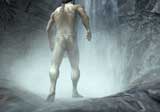 Kengo: Master of Bushindo, while not officially related to the Bushido series,
is clearly in the same vain. The multiple weapons available in Bushido have been removed,
which is too bad, but the dueling system with katanas has been given a serious upgrade.
Each different dojo teaches a variety of different stances and techniques. Each stance is
capable of different combos. New stances and moves are learned by fighting against them.
You can then customize your combos within any given stance, based on the moves you have
learned. This creates an interesting new dimension to the game as you struggle to get the
best combos you can, and this is always changing as you learn new moves. For example, from
the move "Parting the mist", you could choose to go into either a sidestep slash
or a multi thrust, and from both of those into several more moves. Simply pick your four
favorite stances, and customize the combos most suited to your fighting style. It’s
really cool. Especially since in a multi-player game several people may use the same
character, choose the same stances, and still have totally different move lists. Kengo: Master of Bushindo, while not officially related to the Bushido series,
is clearly in the same vain. The multiple weapons available in Bushido have been removed,
which is too bad, but the dueling system with katanas has been given a serious upgrade.
Each different dojo teaches a variety of different stances and techniques. Each stance is
capable of different combos. New stances and moves are learned by fighting against them.
You can then customize your combos within any given stance, based on the moves you have
learned. This creates an interesting new dimension to the game as you struggle to get the
best combos you can, and this is always changing as you learn new moves. For example, from
the move "Parting the mist", you could choose to go into either a sidestep slash
or a multi thrust, and from both of those into several more moves. Simply pick your four
favorite stances, and customize the combos most suited to your fighting style. It’s
really cool. Especially since in a multi-player game several people may use the same
character, choose the same stances, and still have totally different move lists.
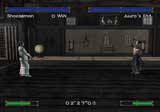 The beginning of the game consists of challenging the other dojos. In doing so
you learn new moves, improve your stats, and can earn special swords by defeating the
entire dojo. Once all the local dojo’s have been defeated you will receive an
invitation to the imperial tournament. Don’t bother bringing your wooden stick to the
imperial tournament; this is the big leagues, and it’s all about steel and turning
your opponent into a twitching blood fountain. After the imperial tournament has been
beaten, it’s back to the dojo. Your goal is basically to keep training, and to kick a
lot of ass. There will be ample opportunity for both. Young upstarts will come to
challenge your dojo, and there’s also an imperial tournament every weak or so. This
is where the one-player game begins to top out, which is too bad because it could have
gone in a lot of really cool directions. A quest mode to go defeat a mysterious evil dude,
or even just walking the earth looking for worthy opponents would have been better than
the rather vauge direction you’re given later in the game. The beginning of the game consists of challenging the other dojos. In doing so
you learn new moves, improve your stats, and can earn special swords by defeating the
entire dojo. Once all the local dojo’s have been defeated you will receive an
invitation to the imperial tournament. Don’t bother bringing your wooden stick to the
imperial tournament; this is the big leagues, and it’s all about steel and turning
your opponent into a twitching blood fountain. After the imperial tournament has been
beaten, it’s back to the dojo. Your goal is basically to keep training, and to kick a
lot of ass. There will be ample opportunity for both. Young upstarts will come to
challenge your dojo, and there’s also an imperial tournament every weak or so. This
is where the one-player game begins to top out, which is too bad because it could have
gone in a lot of really cool directions. A quest mode to go defeat a mysterious evil dude,
or even just walking the earth looking for worthy opponents would have been better than
the rather vauge direction you’re given later in the game.
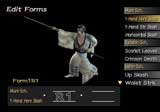 Combat is preformed with three buttons: block, parry, and strike. Block is
self-explanatory; parry is basically a counter that puts you in a good position for a
strike. Strikes are preformed with one button combined with a direction movement, and the
results depend on your stance. Another button is used to give a yell that raises your ki
strength, and when your ki is full you can launch a badass attack. Combat is geared toward
lightning fast strikes and excellent blocking technique. Not every hit will draw blood,
but when one does, you’ll know it. The one-hit-kills of Bushido Blade have been
abandoned, so combat is longer and more intense because there’s always the
possibility of a dramatic come from behind victory. While technically this is a less
realistic system, it’s also a lot more fun. While the single-blow kills are out, some
effort has been made to replace them. Certain hits can reach vital areas, causing intense
bleeding that continues to deplete the characters life total, so it’s possible to get
a good strike in early and play defense and avoid your opponent until they bleed to death.
I found this to be vastly preferable to the Bushido Blade system, but in the future I
would like to see bleeding wounds cause damage faster. The current system, while cool and
innovative, causes loss of life at such a slow rate that it is rarely a factor in
determining the eventual winner. Combat is preformed with three buttons: block, parry, and strike. Block is
self-explanatory; parry is basically a counter that puts you in a good position for a
strike. Strikes are preformed with one button combined with a direction movement, and the
results depend on your stance. Another button is used to give a yell that raises your ki
strength, and when your ki is full you can launch a badass attack. Combat is geared toward
lightning fast strikes and excellent blocking technique. Not every hit will draw blood,
but when one does, you’ll know it. The one-hit-kills of Bushido Blade have been
abandoned, so combat is longer and more intense because there’s always the
possibility of a dramatic come from behind victory. While technically this is a less
realistic system, it’s also a lot more fun. While the single-blow kills are out, some
effort has been made to replace them. Certain hits can reach vital areas, causing intense
bleeding that continues to deplete the characters life total, so it’s possible to get
a good strike in early and play defense and avoid your opponent until they bleed to death.
I found this to be vastly preferable to the Bushido Blade system, but in the future I
would like to see bleeding wounds cause damage faster. The current system, while cool and
innovative, causes loss of life at such a slow rate that it is rarely a factor in
determining the eventual winner.
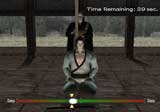 When you’re not swatting people with sticks or slicing them with swords,
it’s time to train. Training is done by a series of mini games. Successful completion
raises the maximum parameters for a given skill, while actual stats can only be improved
in combat. The mini games are pretty basic, although substantially better than training
modes in other fighting games, such as Ready 2 Rumble. Some of them are actually fun,
though others grow a little repetitious after a while. The concept behind each is pretty
cool. In one you stand in the center of a circle composed of lit candles. You have to draw
your sword and extinguish all the candles with one blow. In another you have to chop down
a field of bamboo, while the most innovative one has to be the zen meditation, in which
you have to keep from falling asleep while you meditate. If you succeed you gain valuable
insight, but if you fail then the old man standing behind you whacks you with a board.
There are six training modes in all. When you’re not swatting people with sticks or slicing them with swords,
it’s time to train. Training is done by a series of mini games. Successful completion
raises the maximum parameters for a given skill, while actual stats can only be improved
in combat. The mini games are pretty basic, although substantially better than training
modes in other fighting games, such as Ready 2 Rumble. Some of them are actually fun,
though others grow a little repetitious after a while. The concept behind each is pretty
cool. In one you stand in the center of a circle composed of lit candles. You have to draw
your sword and extinguish all the candles with one blow. In another you have to chop down
a field of bamboo, while the most innovative one has to be the zen meditation, in which
you have to keep from falling asleep while you meditate. If you succeed you gain valuable
insight, but if you fail then the old man standing behind you whacks you with a board.
There are six training modes in all.
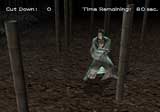 Graphically,
Kengo is pretty solid, although perhaps the character faces are a bit angular most of the
time. The color is mostly earth tones, but it gives the game a sedate, meditating samurai
feel. The aforementioned gore is masterful, although for the benefit of the younger and/or
queasier gamer, the default mode for gore is off-- although in all honesty it never
occurred to me to see what the game was like without gore. The sound is excellent, which
is surprising given the almost complete absence of music. I think this really worked with
the feel of the game; a soundtrack would have detracted from the epic sword fights.
Instead the fight sounds are excellent, the ring of steel is particularly impressive, as
is the thud of wood and the frequent slashing of foes. The sound of the dojo is filled
with the sounds of combat and with sandals running across the wooden floor, accentuated by
the sound of birds chirping and other natural but subtle interjections. Graphically,
Kengo is pretty solid, although perhaps the character faces are a bit angular most of the
time. The color is mostly earth tones, but it gives the game a sedate, meditating samurai
feel. The aforementioned gore is masterful, although for the benefit of the younger and/or
queasier gamer, the default mode for gore is off-- although in all honesty it never
occurred to me to see what the game was like without gore. The sound is excellent, which
is surprising given the almost complete absence of music. I think this really worked with
the feel of the game; a soundtrack would have detracted from the epic sword fights.
Instead the fight sounds are excellent, the ring of steel is particularly impressive, as
is the thud of wood and the frequent slashing of foes. The sound of the dojo is filled
with the sounds of combat and with sandals running across the wooden floor, accentuated by
the sound of birds chirping and other natural but subtle interjections.
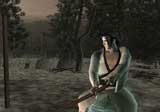 In
future installments, and Kengo certainly warrants them, I would like to see the combat
system expanded to include more combos in each stance. This will most likely require the
addition of another attack button. I’d also like to see the single player mode
expanded to include more of a quest feel to it—even if it’s something as simple
as dots on a map like Soul Calibur. More variety in weapon selection would also be nice.
Finally, while I enjoyed the training mini games, future installments should start
characters more developed. The first hour or so of the game is the least fun because the
characters and their diminutive stats move so blasted slow and only know a couple of
moves. As it stands now, Kengo is still a masterful fighting game that falls just short of
the five star mark. While its fighting system isn’t for everybody, the audience it
finds will be delighted and impressed. It’s worth mentioning that Kengo is much more
user friendly than Bushido Blade, but still requires more timing and precision than your
average fighter. The bottom line is, if you love fighting games and you own a PS2 then you
have to play this game. I mean it. Go do it right now. Don’t make me draw my katana.
I’ve been practicing. In
future installments, and Kengo certainly warrants them, I would like to see the combat
system expanded to include more combos in each stance. This will most likely require the
addition of another attack button. I’d also like to see the single player mode
expanded to include more of a quest feel to it—even if it’s something as simple
as dots on a map like Soul Calibur. More variety in weapon selection would also be nice.
Finally, while I enjoyed the training mini games, future installments should start
characters more developed. The first hour or so of the game is the least fun because the
characters and their diminutive stats move so blasted slow and only know a couple of
moves. As it stands now, Kengo is still a masterful fighting game that falls just short of
the five star mark. While its fighting system isn’t for everybody, the audience it
finds will be delighted and impressed. It’s worth mentioning that Kengo is much more
user friendly than Bushido Blade, but still requires more timing and precision than your
average fighter. The bottom line is, if you love fighting games and you own a PS2 then you
have to play this game. I mean it. Go do it right now. Don’t make me draw my katana.
I’ve been practicing.
Jeff
Luther |
|
Snapshot
Ups: Great graphics; excellent sound; deep fighting system; actually fun
training; nice gore.
Downs: Single player mode fades out after completion; combo systems could be a
little deeper.
System Reqs:
Sony PlayStation 2
|
|
|
|
|
|
Questions? Suggestions? Comments?
Contact us at:
editors@gamesfirst.com |
|
